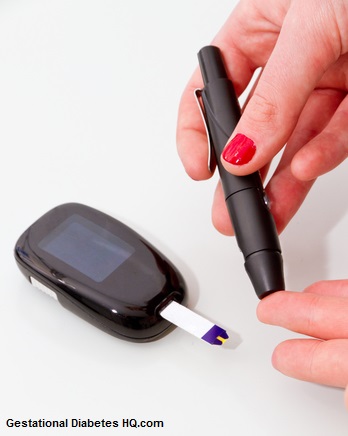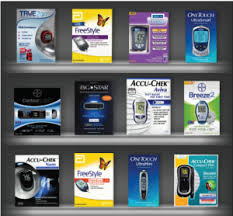
When you have gestational diabetes, the best way to know if your blood sugar is within a healthy range is to test regularly.
By Cynthia D. Smith, PharmD
Testing your blood sugar involves certain steps. That is the “how-to”.
But knowing how to do something, doesn’t mean that you’ll take the time to do it or that you’ll realize the importance of the task. Especially if that something makes you uncomfortable.
So before we get to the HOW of glucose testing, let’s discuss the WHY.
After that we’ll look at the equipment you’ll need and we’ll go step-by-step through the blood sugar testing routine.
Direction and Focus
Pregnancy. Diabetes. Work. Home. Family. Other commitments.
A whirlwind of activities.
There is so much going on in your life right now. Checking your blood sugar is one more thing to squeeze into your crazy schedule.
But testing your blood sugar will keep you focused on what’s important: A healthy mama, giving birth to a healthy baby.
Research has shown that women with gestational diabetes who are able to keep their blood sugar in control have the same chances of a healthy trouble-free birth as a woman without diabetes.
So keeping your blood sugar in check, will improve your likelihood of a healthy birth.
But you won’t know if your blood sugar is in control unless you monitor it.
Testing your blood sugar will give you direction.
Maybe you’ve already made lots of changes to your daily routine. Maybe you’ve changed what you eat. Maybe you’ve added oral diabetes medication or insulin. Maybe you’ve added some healthy, low-impact exercises.
All of those things affect your blood sugar. Is it in a healthy range? Or is it too high? Too low?
You won’t know, if you’re not testing regularly.
Perhaps you’re sticking to your meal plan as best you can, but your sugar levels still aren’t under control.
Don’t wait until your next office visit with your doctor or dietitian to find out that your blood sugar is sky high.
If you test regularly, you’ll have a better indicator of your control.
The changes you’ve made — are they working? Testing will give you room to be proactive.
If things are heading in the wrong direction and your blood sugar sinks too low or rises too high, you’ll know sooner rather than later. And you can act quickly to make necessary changes.
Monitor your blood sugar every day. Write down your results.
Then take your log sheet or notebook or app with you when you visit your doctor, dietitian or diabetes educator.
Together as you review your blood sugar results and compare it to your foods, medication, exercise and other life-style factors, you’ll be better able to fine tune your plan for success.
Because your readings can change based on the time of day and when you ate your last meal as well as what you ate, your log should include the time of day when you tested.
So be consistent, and test at the same time every day. For example if you’re testing before breakfast and after meals, try to keep your meal times consistent.
So now that we know the WHY of testing and its importance, let’s gather the necessary equipment.
Glucose Monitoring Kit
You’ll need a glucose monitoring kit also called a glucometer kit. Your health care provider may provide you with a free kit or may give you a prescription to take to your local pharmacy where your insurance may cover your monitor at low or no cost to you.
Kits usually contain lancets and lancing device, test strips and control solution.
You can call your insurance carrier and find out if they will cover the cost of a glucose monitor. Make a note of the brands they will cover. Also ask if they will pay for supplies such as test strips, lancets, control solution and alcohol wipes–because you’ll need those items on a regular bases.
Once you have the glucose monitor, the biggest expense will be the test strips which normally cost between $10 and $60 per box of 50 test strips depending on the brand, so take that into consideration when choosing a monitor.
You can purchase diabetes supplies from your local pharmacy or online without a prescription but if your insurance will cover the cost, you’ll need a doctor’s prescription.
WHAT TO LOOK FOR IN A MONITOR
 There are many monitors to chose from. Let’s look at some of the available features, and you can note which features are most important to you.
There are many monitors to chose from. Let’s look at some of the available features, and you can note which features are most important to you.
ACCURACY
Manufactures of glucose monitors follow strict guidelines and are overseen by the Food and Drug Administration (FDA) but those standards still leave room for errors that could fall within 15-20% above or below your true value.
But the readings you get even if not 100% accurate are usually within a range close enough to help you decide on a plan of action. A reading that’s a little high for someone not on insulin may mean doing exercise immediately to lower blood sugar.
But a pattern of highs at the same time each day may indicate the need to make changes in medication, food, and/or exercise.
Monitors can also fall victim to human error.
Things you can do to improve meter accuracy.
- Wash your hands before testing.
- Avoid putting on lotion right before testing.
- Be sure the testing site is not damp from rubbing alcohol.
- Calibrate your meter based on manufacturer’s guidelines.
- Drink enough fluids. Dehydration can interfere with proper readings.
- Store your test strips properly.
- Do not use test strips that are past the expiration date.
Food, drink or lotion residue left on your hands can affect your blood glucose reading, so be sure to wash and dry your hands before you test. If you use an alcohol swab, be sure to let the site dry completely before testing.
ENVIRONMENT
Altitude, humidity, and room temperature can all affect your glucose results by affecting your body or the strips you use. Some meters will come with instructions on how to get proper readings in those particular situations.
PRICE
The price of a meter escalates based on the features.
A basic, no frills meter can cost around $10. Meters that can plug into your computer or smart phone or that have rechargeable batteries may cost $75 or more.
The most pricey part of testing is the test strips. You’ll need a new strip each time you test. And test strips must be compatible with the meter. So before you buy the meter, find out how much a box of its test strips will cost you.
MEMORY
How many test results can the meter hold? Do you want to be able to refer back to your readings a week later? A month later?
Some meters can hold up to 500 test results and can also give you weekly and monthly averages.
METER SIZE
Meters come in many shapes and sizes to fit your preferences. Do you want larger numbers to make it easier for you to see the results? Do you want a small meter that fits easily in your hand? It’s your choice.
SPEED OF RESULTS
If you’ll be testing many times during the day, you may want a meter that will give you results in 5 seconds or less.
SIZE OF BLOOD DROP NEEDED
Meters need a specific amount of blood (measured in microliters) in order to work properly and give you an accurate reading.
OTHER AVAILABLE FEATURES
- Audio Capability
- Backlighting
- Wireless Bluetooth Capability
HOW TO TEST
Overview
- Wash your hands with warm, soapy water. Dry your hands before testing.
- Prepare your lancing device.
- Remove a test strip from the container. Close the lid tightly to keep the remaining strips protected.
- Insert the test strip into the meter.
- Prick the the side of your finger tip with your lancet device. Then squeeze your finger a bit.
- Gently touch the test strip against the drop of blood until enough blood has been drawn into the strip.
- Your reading will appear on your monitor.
- Using a cotton ball, apply a bit of pressure to your finger. Bandage, optional.
- Properly discard your test strip and lancet. (Sharps container or an empty detergent bottle or empty coffee can will do.)
- Record your reading using a written log or save it to your meter’s memory if it has the capability.
Demonstration
Watch this short video demonstration sponsored by WebMD.
If you’re looking for a glucose monitoring kit, there are many kits available and you can read their customer product reviews on Amazon and compare their customer star ratings. Here are two that I’ve chosen:
Bayer Contour NEXT EZ Blood Glucose Monitoring Kit
- Easy to use, no coding required
- Results in as little as 5 seconds
- Kit includes: Contour Next EZ meter, 50 test strips, 100 lancets, lancing device, alcohol pads, control solution, instructions/owner’s manual, logbook and carrying case
FreeStyle Lite Blood Glucose Monitoring System
- Convenient, no coding required
- Fast, 5-second average test time
- Small sample size 0.3 microliter
- Small meter size to use on the go
- Stores up to 400 results with date and time
- Kit includes: FreeStyle meter, lancing device, carrying case, 10 lancets, 10 test strips, control solution, and owner’s booklet
If you don’t have a glucose monitor, get one today. If you do have a monitor and haven’t used it yet, then use it now.
And use it regularly. Know you numbers and share them with your health care provider.
Here’s to a healthy mama, healthy baby.